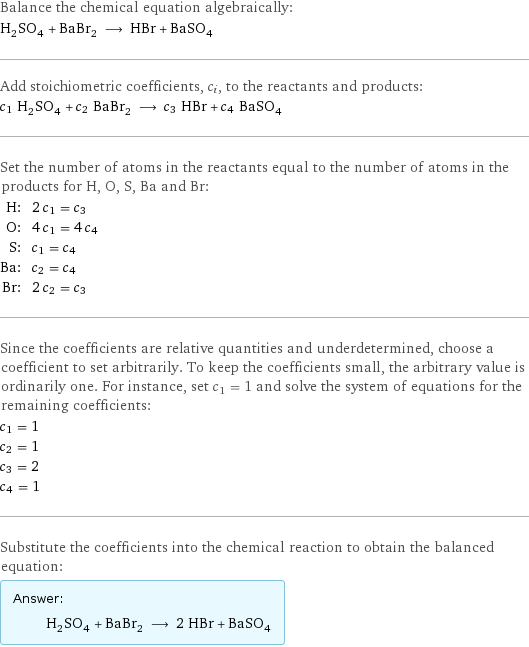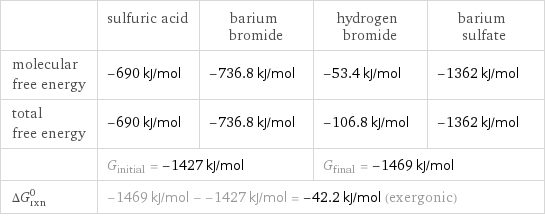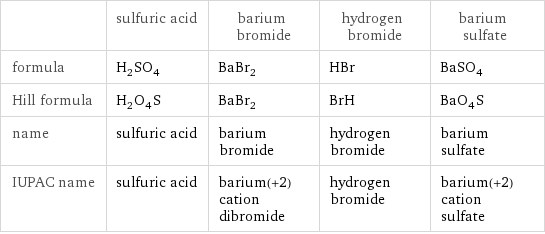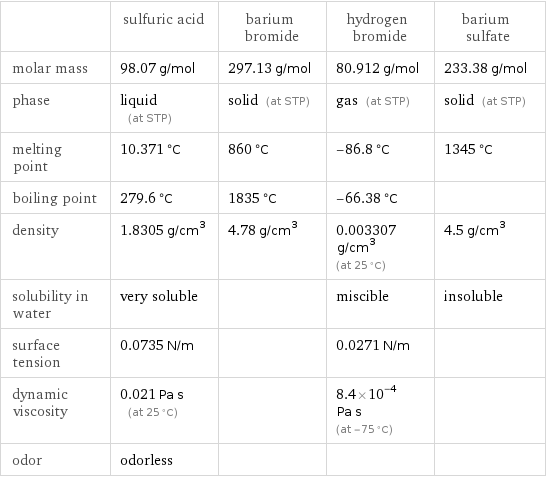Input interpretation

H_2SO_4 sulfuric acid + BaBr_2 barium bromide ⟶ HBr hydrogen bromide + BaSO_4 barium sulfate
Balanced equation

Balance the chemical equation algebraically: H_2SO_4 + BaBr_2 ⟶ HBr + BaSO_4 Add stoichiometric coefficients, c_i, to the reactants and products: c_1 H_2SO_4 + c_2 BaBr_2 ⟶ c_3 HBr + c_4 BaSO_4 Set the number of atoms in the reactants equal to the number of atoms in the products for H, O, S, Ba and Br: H: | 2 c_1 = c_3 O: | 4 c_1 = 4 c_4 S: | c_1 = c_4 Ba: | c_2 = c_4 Br: | 2 c_2 = c_3 Since the coefficients are relative quantities and underdetermined, choose a coefficient to set arbitrarily. To keep the coefficients small, the arbitrary value is ordinarily one. For instance, set c_1 = 1 and solve the system of equations for the remaining coefficients: c_1 = 1 c_2 = 1 c_3 = 2 c_4 = 1 Substitute the coefficients into the chemical reaction to obtain the balanced equation: Answer: | | H_2SO_4 + BaBr_2 ⟶ 2 HBr + BaSO_4
Structures

+ ⟶ +
Names

sulfuric acid + barium bromide ⟶ hydrogen bromide + barium sulfate
Reaction thermodynamics
Enthalpy

| sulfuric acid | barium bromide | hydrogen bromide | barium sulfate molecular enthalpy | -814 kJ/mol | -757.3 kJ/mol | -36.3 kJ/mol | -1473 kJ/mol total enthalpy | -814 kJ/mol | -757.3 kJ/mol | -72.6 kJ/mol | -1473 kJ/mol | H_initial = -1571 kJ/mol | | H_final = -1546 kJ/mol | ΔH_rxn^0 | -1546 kJ/mol - -1571 kJ/mol = 25.5 kJ/mol (endothermic) | | |
Gibbs free energy

| sulfuric acid | barium bromide | hydrogen bromide | barium sulfate molecular free energy | -690 kJ/mol | -736.8 kJ/mol | -53.4 kJ/mol | -1362 kJ/mol total free energy | -690 kJ/mol | -736.8 kJ/mol | -106.8 kJ/mol | -1362 kJ/mol | G_initial = -1427 kJ/mol | | G_final = -1469 kJ/mol | ΔG_rxn^0 | -1469 kJ/mol - -1427 kJ/mol = -42.2 kJ/mol (exergonic) | | |
Equilibrium constant
![Construct the equilibrium constant, K, expression for: H_2SO_4 + BaBr_2 ⟶ HBr + BaSO_4 Plan: • Balance the chemical equation. • Determine the stoichiometric numbers. • Assemble the activity expression for each chemical species. • Use the activity expressions to build the equilibrium constant expression. Write the balanced chemical equation: H_2SO_4 + BaBr_2 ⟶ 2 HBr + BaSO_4 Assign stoichiometric numbers, ν_i, using the stoichiometric coefficients, c_i, from the balanced chemical equation in the following manner: ν_i = -c_i for reactants and ν_i = c_i for products: chemical species | c_i | ν_i H_2SO_4 | 1 | -1 BaBr_2 | 1 | -1 HBr | 2 | 2 BaSO_4 | 1 | 1 Assemble the activity expressions accounting for the state of matter and ν_i: chemical species | c_i | ν_i | activity expression H_2SO_4 | 1 | -1 | ([H2SO4])^(-1) BaBr_2 | 1 | -1 | ([BaBr2])^(-1) HBr | 2 | 2 | ([HBr])^2 BaSO_4 | 1 | 1 | [BaSO4] The equilibrium constant symbol in the concentration basis is: K_c Mulitply the activity expressions to arrive at the K_c expression: Answer: | | K_c = ([H2SO4])^(-1) ([BaBr2])^(-1) ([HBr])^2 [BaSO4] = (([HBr])^2 [BaSO4])/([H2SO4] [BaBr2])](../image_source/67b9f6c7797c477b01949941ae8ffaa4.png)
Construct the equilibrium constant, K, expression for: H_2SO_4 + BaBr_2 ⟶ HBr + BaSO_4 Plan: • Balance the chemical equation. • Determine the stoichiometric numbers. • Assemble the activity expression for each chemical species. • Use the activity expressions to build the equilibrium constant expression. Write the balanced chemical equation: H_2SO_4 + BaBr_2 ⟶ 2 HBr + BaSO_4 Assign stoichiometric numbers, ν_i, using the stoichiometric coefficients, c_i, from the balanced chemical equation in the following manner: ν_i = -c_i for reactants and ν_i = c_i for products: chemical species | c_i | ν_i H_2SO_4 | 1 | -1 BaBr_2 | 1 | -1 HBr | 2 | 2 BaSO_4 | 1 | 1 Assemble the activity expressions accounting for the state of matter and ν_i: chemical species | c_i | ν_i | activity expression H_2SO_4 | 1 | -1 | ([H2SO4])^(-1) BaBr_2 | 1 | -1 | ([BaBr2])^(-1) HBr | 2 | 2 | ([HBr])^2 BaSO_4 | 1 | 1 | [BaSO4] The equilibrium constant symbol in the concentration basis is: K_c Mulitply the activity expressions to arrive at the K_c expression: Answer: | | K_c = ([H2SO4])^(-1) ([BaBr2])^(-1) ([HBr])^2 [BaSO4] = (([HBr])^2 [BaSO4])/([H2SO4] [BaBr2])
Rate of reaction
![Construct the rate of reaction expression for: H_2SO_4 + BaBr_2 ⟶ HBr + BaSO_4 Plan: • Balance the chemical equation. • Determine the stoichiometric numbers. • Assemble the rate term for each chemical species. • Write the rate of reaction expression. Write the balanced chemical equation: H_2SO_4 + BaBr_2 ⟶ 2 HBr + BaSO_4 Assign stoichiometric numbers, ν_i, using the stoichiometric coefficients, c_i, from the balanced chemical equation in the following manner: ν_i = -c_i for reactants and ν_i = c_i for products: chemical species | c_i | ν_i H_2SO_4 | 1 | -1 BaBr_2 | 1 | -1 HBr | 2 | 2 BaSO_4 | 1 | 1 The rate term for each chemical species, B_i, is 1/ν_i(Δ[B_i])/(Δt) where [B_i] is the amount concentration and t is time: chemical species | c_i | ν_i | rate term H_2SO_4 | 1 | -1 | -(Δ[H2SO4])/(Δt) BaBr_2 | 1 | -1 | -(Δ[BaBr2])/(Δt) HBr | 2 | 2 | 1/2 (Δ[HBr])/(Δt) BaSO_4 | 1 | 1 | (Δ[BaSO4])/(Δt) (for infinitesimal rate of change, replace Δ with d) Set the rate terms equal to each other to arrive at the rate expression: Answer: | | rate = -(Δ[H2SO4])/(Δt) = -(Δ[BaBr2])/(Δt) = 1/2 (Δ[HBr])/(Δt) = (Δ[BaSO4])/(Δt) (assuming constant volume and no accumulation of intermediates or side products)](../image_source/fe1596c362b936e50c95f768f675af48.png)
Construct the rate of reaction expression for: H_2SO_4 + BaBr_2 ⟶ HBr + BaSO_4 Plan: • Balance the chemical equation. • Determine the stoichiometric numbers. • Assemble the rate term for each chemical species. • Write the rate of reaction expression. Write the balanced chemical equation: H_2SO_4 + BaBr_2 ⟶ 2 HBr + BaSO_4 Assign stoichiometric numbers, ν_i, using the stoichiometric coefficients, c_i, from the balanced chemical equation in the following manner: ν_i = -c_i for reactants and ν_i = c_i for products: chemical species | c_i | ν_i H_2SO_4 | 1 | -1 BaBr_2 | 1 | -1 HBr | 2 | 2 BaSO_4 | 1 | 1 The rate term for each chemical species, B_i, is 1/ν_i(Δ[B_i])/(Δt) where [B_i] is the amount concentration and t is time: chemical species | c_i | ν_i | rate term H_2SO_4 | 1 | -1 | -(Δ[H2SO4])/(Δt) BaBr_2 | 1 | -1 | -(Δ[BaBr2])/(Δt) HBr | 2 | 2 | 1/2 (Δ[HBr])/(Δt) BaSO_4 | 1 | 1 | (Δ[BaSO4])/(Δt) (for infinitesimal rate of change, replace Δ with d) Set the rate terms equal to each other to arrive at the rate expression: Answer: | | rate = -(Δ[H2SO4])/(Δt) = -(Δ[BaBr2])/(Δt) = 1/2 (Δ[HBr])/(Δt) = (Δ[BaSO4])/(Δt) (assuming constant volume and no accumulation of intermediates or side products)
Chemical names and formulas

| sulfuric acid | barium bromide | hydrogen bromide | barium sulfate formula | H_2SO_4 | BaBr_2 | HBr | BaSO_4 Hill formula | H_2O_4S | BaBr_2 | BrH | BaO_4S name | sulfuric acid | barium bromide | hydrogen bromide | barium sulfate IUPAC name | sulfuric acid | barium(+2) cation dibromide | hydrogen bromide | barium(+2) cation sulfate
Substance properties

| sulfuric acid | barium bromide | hydrogen bromide | barium sulfate molar mass | 98.07 g/mol | 297.13 g/mol | 80.912 g/mol | 233.38 g/mol phase | liquid (at STP) | solid (at STP) | gas (at STP) | solid (at STP) melting point | 10.371 °C | 860 °C | -86.8 °C | 1345 °C boiling point | 279.6 °C | 1835 °C | -66.38 °C | density | 1.8305 g/cm^3 | 4.78 g/cm^3 | 0.003307 g/cm^3 (at 25 °C) | 4.5 g/cm^3 solubility in water | very soluble | | miscible | insoluble surface tension | 0.0735 N/m | | 0.0271 N/m | dynamic viscosity | 0.021 Pa s (at 25 °C) | | 8.4×10^-4 Pa s (at -75 °C) | odor | odorless | | |
Units
